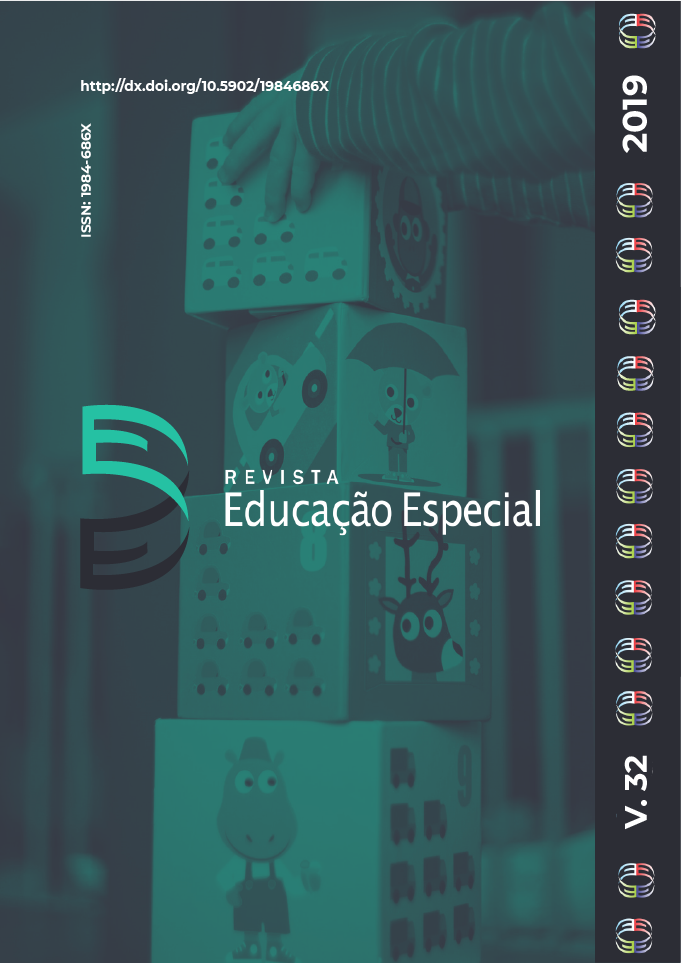Learning of positions in hippotherapy by children with autistic spectrum disorders (ASD)
DOI:
https://doi.org/10.5902/1984686X32575Keywords:
Special Education, Hippotherapy, Autism.Abstract
The study analyzed the levels of physical-verbal assistance, visual-verbal assistance, and verbal communication in the process of learning positions in hippotherapy by children with Autistic Spectrum Disorder (ASD). The research method was based on a single subject design, type AB, involving three children with ASD with ages between four and nine years. Participants were submitted to 31 individual sessions of hippotherapy, during four months, twice a week. Instruments used for data collection were: 1. Anamnesis filled in with parents or guardians; 2. Protocol for Assessment of Basic Learning Abilities (ABLA); 3. Field diary; 4. Daily recording checklist for each of the aids used during each session of hippotherapy. Descriptive analysis regarding the evolution of each participant was used. At the end of the intervention it was observed that all participants were able to perform all positions with exclusively verbal assistance. The learning process was mediated by visual-verbal and physical-verbal aids with the latter being more predominant. Thus, levels and types of aid needed to learn positioning will vary according to the individual needs of child with ASD, and there is no single efficient type of method; however, it is observed that the association of stimuli in a directed way can lead to success in the child's learning.Downloads
References
ANDE-BRASIL, 2. Equoterapia: considerações complementares. , 2012. Acesso em: 08 novembro 2012.
ALMEIDA, A. Como ensinar crianças autistas, de 21 de abril de 2012. Disponível em:< http://pedagogiaaopedaletra.com/como-ensinar-criancas-autistas/. Acesso em 26 ago 16.
BARBOSA, Gardenia de Oliveira. Efeito de um programa de equoterapia nos aspectos psicomotores de crianças com indicativos do TDAH. 2005. 193 f. Dissertação (Mestrado em Educação Especial) - Centro de Educação e Ciências Humanas, Universidade Federal de São Carlos. São Carlos, 2013.
COZBY, Paul. Métodos de Pesquisa em Ciências do Comportamento. São Paulo: Atlas, 2011. 238-249 p.
DE WIELE, L. MARTIN, Garry. Assessment of basic learning abilities: a self instructional manual. Canadá: Manitoba Developmental Centre, 1998. 59 p. Manual
DSM 5. Diagnostic and Statistical Manual of Mental Disorders. 5 edição. [S.l.]: [s.n.], 2013.
FETSCH, Christopher; DEANGELIS, Gregory; ANGELAKI, Dora. Visual–vestibular cue integration for heading perception: applications of optimal cue integration theory. European Journal of Neuroscience, v. 31, pp. 1721-1729, 2010. DOI: https://doi.org/10.1111/j.1460-9568.2010.07207.x
FITTIPALDI-WERT, Jeanine., MOWLING, Claire. Using visual supports for students with autism in physical education. JOPERD, v. 80, n. 2, p. 39-48, 2009. DOI: https://doi.org/10.1080/07303084.2009.10598281
GAST, David.; LEDFORD, Jennifer. Single case research methodology: applications in special education and behavioral sciences. 2 ed. New York: Routledge, 2014, 462 p. DOI: https://doi.org/10.4324/9780203521892
GUILHARDI, Cintia. Potencial preditivo do teste ABLA na aquisição de treinos de discriminações condicionais auditivo-visuais e teste de outras discriminações condicionais. 2003. 245 f. Dissertação (Mestrado em Psicologia) - Pontifícia Universidade Católica de São Paulo, São Paulo, 2003.
KLIN, Ami. et al. Avaliação clínica de crianças com risco de autismo. Educação, Porto Alegre, v.58, n.1, p.255-297, 2006.
MARTIN, Garry. et al. The assessment of basic learning abilities test for predicting learning of persons with intellectual disabilities. Behavior Modification, v. 32, n. 2, p.228-247, 2008. DOI: https://doi.org/10.1177/0145445507309022
NEMETH, Dezso. et al. Learning in Autism: Implicity Superb. Plos ONE, v.5, n.7, p. 1-7, 2010. DOI: https://doi.org/10.1371/journal.pone.0011731
SCHMIDT, Carlo. Temple Grandin e o autismo: uma análise do filme. Revista Brasileira de Educação Especial, v.18, n. 2, p. 179-194, 2012. DOI: https://doi.org/10.1590/S1413-65382012000200002
SEAVER, Jessica; BOURRET, Jason. An evaluation of response prompts for teaching behavior chains. Journal of applied behavior analysis, v. 47, n. 4, p. 777-792, 2014. DOI: https://doi.org/10.1002/jaba.159
SILVA, Mirelly; BALBINO, Elizete. A importância da formação do professor frente ao transtorno do espectro autista – tea: estratégias educativas adaptadas. In: Encontro ALAGOANO DE EDUCAÇÃO INCLUSIVA, 6. Universidade Federal de Alagoas, dezembro 2015.
VERBEKE, Aynsley. et al. Does ABLA Test Performance on the ABLA Test Predict Picture Receptive Name Recognition with Persons with severe Developmental Disabilities? The analysis of verbal behavior, Canda, v. 23, n.1, p. 35-39, 2007. DOI: https://doi.org/10.1007/BF03393045
WALLS, R. T.; ELLIS, W. D.; ZANE, T.; VANDERPOEL, S. J. Tactile, auditory, and visual prompting in teaching complex assembly tasks. Education and Training of the Mentally Retarded, v.14, n.2, 120–130, 1979.
WALTER, Catia. Avaliação de um programa de comunicação alternativa e ampliada para mães de adolescentes com autismo. 2006. 137 f. Tese (Doutorado em Educação Especial) - Centro de Educação e Ciências Humanas, Universidade Federal de São Carlos. São Carlos, 2006.
Downloads
Published
How to Cite
Issue
Section
License
Declaration of originality
We declare that all articles present in the journal Revista Educação Especial (UFSM) are originals and were not submitted for publishing on any other publication, as a whole or a fraction. We also declare that, after being published by Revista Educação Especial (UFSM), a paper will not be submitted to another journal within two years. After this time, our journal transfers the publishing rights to the authors, with a permit granted by the Editorial Council.
We also acknowledge that the originals’ submission to Revista Educação Especial (UFSM) implies on a transference of copyright for physical and digital publishing to the journal. In case of noncompliance, the violator will receive sanctions and penalties predicted by the Brazilian Copyright Protection Law (n. 9610, dated 19/02/98).







